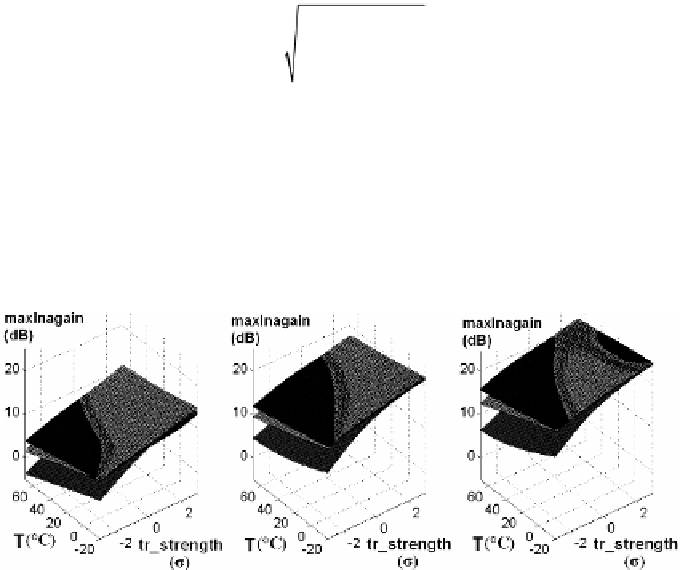Information Technology Reference
In-Depth Information
The adaptive sampling method LOLA-Voronoi [5] determined the non-linear regions
of the true response and sampled those more densely. 5-fold cross validation with
root-relative-square-error (RRSE) was used for the model validation. The definition
of RRSE is defined as
n
2
(
yy
yy
−
)
i
i
RRSE
=
i
n
=
1
(1)
(
−
)
2
i
i
=
1
where
y
,
y
and
y
are the actual, predicted, and mean actual response values.
The constructed model has an RRSE of 4.72%. Fig. 4 shows the plots of the model
surfaces used to explore the design space. The results show the effects of the design
parameters and the parametric variations. It is seen that both transistor variations and
temperature variations can significantly impact performance. It is possible to mod-
ulate the design parameters, in order to achieve an optimal gain value under the spe-
cific variations.
(a) mlna=0.5 (b)mlna=1.25 (c)mlna=2
Fig. 4.
Plot of the model surfaces. (a)—(c) are for different mlna values. The three slices in
each plot are for three
I
ref
values. Black is for 50 μA, light grey is for 125μA, and dark grey is
for 200μA.
3
Scalable and Variation-Sensitive IO Macromodel
Good macromodels of input/output circuits are essential for fast timing, signal-
integrity, and power-integrity analysis in high-speed digital systems. The most popu-
lar approach to IO modelling is to use the traditional table-based input-output buffer
information specification (IBIS) [9]. IBIS models are simple, portable, IP-protected,
and fast in simulation. However, they are unable to simulate continuous PVT varia-
tions and unsuitable for statistical analysis. We propose a new type of macromodel,
called the surrogate IBIS model, to solve the problem [10]. In the new method, an
equivalent circuit structure is used to capture the static and dynamic circuit behaviors,
while surrogate modeling is used to approximate each element over a range of
Process-Voltage-Temperature (PVT) parameters, so that the macromodel is able to
dynamically adapt to the PVT variations in analysis.

Search WWH ::

Custom Search